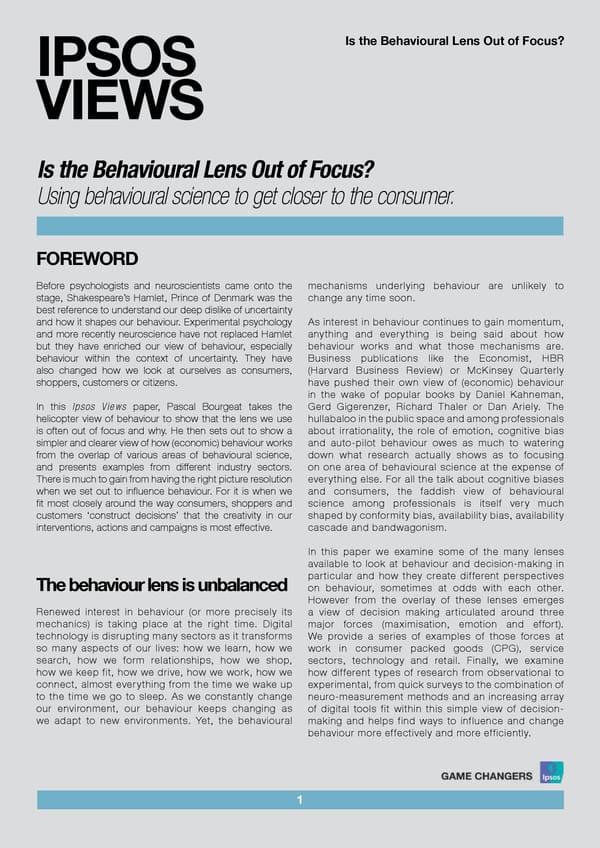IPSOS Is the Behavioural Lens Out of Focus? VIEWS Is the Behavioural Lens Out of Focus? Using behavioural science to get closer to the consumer. FOREWORD Before psychologists and neuroscientists came onto the mechanisms underlying behaviour are unlikely to stage, Shakespeare’s Hamlet, Prince of Denmark was the change any time soon. best reference to understand our deep dislike of uncertainty and how it shapes our behaviour. Experimental psychology As interest in behaviour continues to gain momentum, and more recently neuroscience have not replaced Hamlet anything and everything is being said about how but they have enriched our view of behaviour, especially behaviour works and what those mechanisms are. behaviour within the context of uncertainty. They have Business publications like the Economist, HBR also changed how we look at ourselves as consumers, (Harvard Business Review) or McKinsey Quarterly shoppers, customers or citizens. have pushed their own view of (economic) behaviour in the wake of popular books by Daniel Kahneman, In this Ipsos Views paper, Pascal Bourgeat takes the Gerd Gigerenzer, Richard Thaler or Dan Ariely. The helicopter view of behaviour to show that the lens we use hullabaloo in the public space and among professionals is often out of focus and why. He then sets out to show a about irrationality, the role of emotion, cognitive bias simpler and clearer view of how (economic) behaviour works and auto-pilot behaviour owes as much to watering from the overlap of various areas of behavioural science, down what research actually shows as to focusing and presents examples from different industry sectors. on one area of behavioural science at the expense of There is much to gain from having the right picture resolution everything else. For all the talk about cognitive biases when we set out to influence behaviour. For it is when we and consumers, the faddish view of behavioural fit most closely around the way consumers, shoppers and science among professionals is itself very much customers ‘construct decisions’ that the creativity in our shaped by conformity bias, availability bias, availability interventions, actions and campaigns is most effective. cascade and bandwagonism. In this paper we examine some of the many lenses available to look at behaviour and decision-making in The behaviour lens is unbalanced particular and how they create different perspectives on behaviour, sometimes at odds with each other. However from the overlay of these lenses emerges Renewed interest in behaviour (or more precisely its a view of decision making articulated around three mechanics) is taking place at the right time. Digital major forces (maximisation, emotion and effort). technology is disrupting many sectors as it transforms We provide a series of examples of those forces at so many aspects of our lives: how we learn, how we work in consumer packed goods (CPG), service search, how we form relationships, how we shop, sectors, technology and retail. Finally, we examine how we keep fit, how we drive, how we work, how we how different types of research from observational to connect, almost everything from the time we wake up experimental, from quick surveys to the combination of to the time we go to sleep. As we constantly change neuro-measurement methods and an increasing array our environment, our behaviour keeps changing as of digital tools fit within this simple view of decision- we adapt to new environments. Yet, the behavioural making and helps find ways to influence and change behaviour more effectively and more efficiently. 1
 Is the Behavioural Lens Out of Focus? Page 2 Page 4
Is the Behavioural Lens Out of Focus? Page 2 Page 4